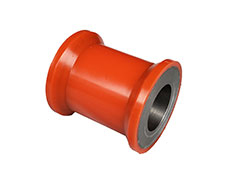Casting process and mold design of polyurethane roller
 Polyurethane roller generally refers to a cylindrical
product with a metal core in the middle and polyurethane outside. According to
the purpose, it is divided into metallurgy, papermaking, textile, food
processing, printing polyurethane roller, etc. Compared with ordinary rubber
rollers, polyurethane rubber rollers have the characteristics of high
mechanical strength, good oil and abrasion resistance, outstanding compression
resistance, wide range of hardness, superior machining performance, high
surface finish and high bonding strength with metal cores. It is more suitable
for use under high line speed and high line pressure. In recent years, this
type of rubber roller has been widely used in various industries to replace the
general rubber roller.
Polyurethane roller generally refers to a cylindrical
product with a metal core in the middle and polyurethane outside. According to
the purpose, it is divided into metallurgy, papermaking, textile, food
processing, printing polyurethane roller, etc. Compared with ordinary rubber
rollers, polyurethane rubber rollers have the characteristics of high
mechanical strength, good oil and abrasion resistance, outstanding compression
resistance, wide range of hardness, superior machining performance, high
surface finish and high bonding strength with metal cores. It is more suitable
for use under high line speed and high line pressure. In recent years, this
type of rubber roller has been widely used in various industries to replace the
general rubber roller.
The formulas of
PU rubber rollers vary widely, but the casting process is roughly the same. The
CPU rubber roller molding method can adopt normal pressure casting, vacuum
stress-free casting, rotary casting, and casting molding. The most commonly
used method is normal pressure casting.
The mold of the
PU rubber roller should be designed according to the size of the urethaneroller,
the pouring method, and the complexity of the product structure. Generally
speaking, Huff molds are mostly used for rubber rollers with large external
dimensions, thin adhesive layers, large production volumes, and complex
geometric shapes, while integral molds are used instead. When designing the
mold, an appropriate machining allowance should be left according to the
shrinkage rate and finishing amount of polyurethane rollers with different
hardness.










